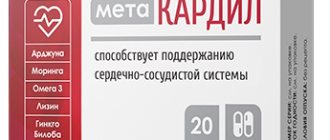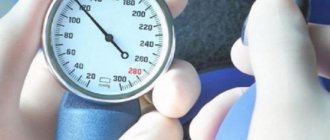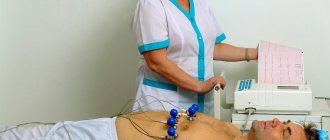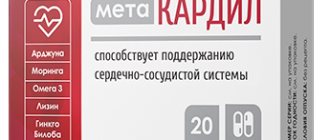There are times when a hypertensive patient or a patient with hypotension does not have access to a tonometer and is puzzled by how to determine blood pressure without the device. Measuring blood pressure has several ways in which you can measure it at home. But you should not completely trust these methods, since only a tonometer can accurately determine the indicators. It is possible to understand whether blood pressure is high or low. You need to learn how to measure it, knowing simple ways. This will require practice and the ability to recognize body signals.
Methods for measuring pressure using improvised means
There are several options. The most common ways are:
- Pulse pressure measurement.
- Determination of indicators by symptoms.
- Using a pendulum and ruler.
In the first and second cases, special attention is paid to symptoms. But the third method is controversial in medical circles. Its effectiveness raises a number of doubts among experts. It has not been officially confirmed by any scientific research, and by and large it is classified in the field of bioenergy.
Although there is no scientific evidence for this type of pressure measurement, it is widely used in critical situations. It is quite popular in certain circles, and even a huge amount of copyright evidence has been created, confirmed by video material, articles and facts. Whether to believe this method or not - the decision remains directly with the person himself.
Picture for general chat: mistakes made by believers on Forgiveness Sunday
The paying audience of online cinemas in the Russian Federation increased 1.5 times over the year
“No clothes on chairs or doors”: tips for cleaning up your apartment
Symptoms of high and low blood pressure
Measure the pressure using the device 3-4 times at regular intervals.
Hypotension, in most cases, is a hereditary disease. It often affects thin young people. Symptoms of low blood pressure are more severe in women. The cardiovascular system cannot cope with the delivery of blood to the brain. This often occurs in stuffy rooms, in the sun, after eating. Based on the symptoms, it is easy to distinguish a hypertensive patient from a patient with hypotension. The following signs are noted:
- pale facial skin;
- sensitivity to cold;
- loss of strength after waking up;
- exhaustion;
- frequent fainting;
- depression;
- insomnia.
The pathological condition may manifest itself as redness of the whites of the eyes.
With hypertension, the first signs are invisible and grow slowly, which can lead to missing the moment. High blood pressure manifests itself in redness of the whites of the eyes and a bright blush on the cheeks. Women during menopause confuse their similar symptoms (headache, hot flashes, nervousness, dizziness). Some conditions are mild (blush on the face, increased energy, shortness of breath).
Signs of high blood pressure are:
- throbbing headache in the back of the head after stress;
- difficulty falling asleep;
- nightmares;
- ringing and noise in the ears;
- dizziness;
- numbness of the tongue and limbs;
- bluish lips;
- poor blood supply to the extremities;
- high eye pressure.
Measuring pressure using a pendulum and centimeter scale
This is a very simple technique. An ordinary ruler is used as a centimeter scale. A pendulum can be made from the most basic available materials.
To do this, you will need a thread, thin rope or cord 15-20 cm long. You can use a ring, nut or bent wire as a weight for the pendulum. Even a sewing needle can work. To make a pendulum, a weight must be tied to a thread.
How to measure blood pressure without a tonometer - 4 effective ways
People suffering from hypertension are often faced with a situation where it is necessary to measure blood pressure without a tonometer. Advances in modern technology and medicine have greatly simplified this task. You can determine blood pressure without a tonometer using specialized electrical devices and Android applications. There are other alternative techniques that are characterized by fairly high levels of accuracy and information content.
This technique has been used to measure blood pressure without a blood pressure monitor for many decades. Experts consider this method to be quite accurate and reliable. However, it is necessary to pay attention to the circumstances and related factors. For example, you should not measure your blood pressure after physical activity or stressful situations that increase your heart rate.
What pressure is considered normal?
Normal blood pressure for an adult is in the range of 91–139/61–89 mmHg. Art. In this case, the absolute norm is 120/80 mmHg. Art.
However, it should be understood that normal blood pressure is an individual indicator for each person, the main thing is that it is within the above limits. For example, a blood pressure of 120/80 is normal for one person, high for another, and low for a third.
Low pressure (below 90/60 mm Hg) is called hypotension, and high pressure (above 140/90 mm Hg) is called hypertension.
Low pressure (below 90/60 mm Hg) is called hypotension, and high pressure (above 140/90 mm Hg) is called hypertension.
Measurement Instructions
To measure pressure in this way, you must carry out the procedure while sitting. The left hand should be placed on a hard surface, the elbow joint should be at the bottom, the bend at the top. You need to put a ruler on your hand.
The pendulum should be held under the ulnar fossa of the forearm, where the beginning of the scale is located. It should not touch your hand, the distance from the ruler to the pendulum is 1-2 cm. You cannot move during the measurement. After the oscillations of the pendulum have calmed down and it has become motionless, within a few seconds it is necessary to slowly move it parallel to the arm from the bend of the joint to the wrist.
After some time, he will begin to make clear transverse swaying movements, which must be fixed. This mark, multiplied by 10, will be the upper indicator of systolic pressure. The lower indicator is determined in the same way, only the direction of the pendulum needs to be changed in the opposite direction from the hand to the elbow joint. Then the indicator must also be multiplied by 10.
This is a simple way to find out your blood pressure. If there is any doubt, the procedure must be repeated.
Found a violation? Report content
Many people nowadays measure blood pressure with semi-automatic and automatic devices. The measurement is simple, you don't need to listen to anything. It would seem, what nuances can we talk about...
Of course, the most accurate tonometer is a manual one. Automatic or semi-automatic machines may have errors. The further the cuff is located from the shoulder, the more unreliable the numbers are. Therefore, those tonometers that are worn on the finger or on the forearm can be used by athletes or simply healthy people to monitor the load and level of training.
For those who have health problems, only devices that measure pressure on the shoulder are suitable. This is the law. You can call this the first nuance.
As a rule, the pressure returns to normal after five minutes of rest. Therefore, before measuring your blood pressure, you need to give yourself a little rest and sit quietly. This applies to both athletes and hypertensive patients. Avoid drinking coffee. The last cup should be drunk at least an hour before the test, and the last cigarette smoked at least a quarter of an hour. If we use these recommendations in reverse, we will receive precise instructions on how a healthy person can raise his blood pressure and “earn” sick leave.
To get the most correct values, pressure should be measured while sitting. The arm is bent at the elbow at an angle of 90 degrees. The cuff is at the level of the heart. The lower edge of the cuff is 2 cm above the elbow. We quickly pump in air - approximately 20 mm Hg after the pulse disappears. We bleed air at a speed of 2–3 mm per second. The semi-automatic machine will do it itself.
However, one measurement is not enough. To obtain reliable data, it is necessary to make three measurements with an interval of at least one minute. The resulting average figure from three measurements will be closest to the correct blood pressure value. For example, with upper pressure figures of 140, 135 and 130, the correct value will be considered 135. And the same with the lower one.
Pressure can be measured using a ring and ruler. The ruler is applied with a “toe” to the beginning of the second fold on the forearm. Take the ring by the thread and slowly lead it in increasing numbers. The first time it jerks is the lower pressure, the second time it jerks is the upper pressure.
The ruler and pendulum are most likely the result of self-hypnosis. A person’s hand will tremble at the very moment when he feels his pressure. And if you measure it with the device, the numbers will certainly be confirmed. This is a very important conclusion: a person can control his blood pressure. True, sometimes it gets out of his control. As a reminder of the numbers, blood pressure of 140/90 or higher is a cause for concern.
A ruler and a thread with a ring - that’s your tonometer
I learned about this method of measuring blood pressure about thirty years ago.
Despite the fact that many medical workers are skeptical about it, it was a doctor who told me about it - a paramedic at the first-aid post at the factory where I began my working life. I WAS suffering from vegetative-vascular dystonia then. Of course, people do not die from this disease, but there is little joy from it either. I learned about this method of measuring blood pressure about thirty years ago. Despite the fact that many medical workers are skeptical about it, it was a doctor who told me about it - a paramedic at the first-aid post at the factory where I began my working life.
I WAS suffering from vegetative-vascular dystonia then. Of course, people do not die from this disease, but there is little joy from it either. After I visited our first-aid post several times to measure my blood pressure, the paramedic demonstrated this simple method to me. There weren’t many tonometers on sale at that time, and they cost a lot. You don’t have to rush to the clinic every time, so I took the paramedic’s story into account. Moreover, she convinced me of the effectiveness of this method, each time checking its readings on a special medical device.
It consists of the following: take an ordinary school ruler no more than 20 - 25 centimeters long for ease of placement on the inside of the arm up to the elbow. Through a ring made of any one alloy - gold or silver, but without a stone - a thread 50 - 60 centimeters long is threaded so that the ring is in the middle. The device is ready. Now we place the ruler on the inside of the arm, setting the zero at the place of the wrist bend. For ease of measurement, the ruler is usually placed on the left hand. Take the thread with the ring in your right hand and slowly, without jerking, move the ring along the ruler from zero to the top of the scale. First, the ring begins to oscillate from left to right as it reads your lower pressure. Hold the thread with the ring at the point of vibration for some time and continue to move further along the ruler scale. The second time the ring will begin to fluctuate at your upper pressure number. You can measure blood pressure in this way not only for yourself, but also for someone else.
Over the course of my long life, I have seen more than once the effectiveness of this method. The pressure readings, of course, diverge somewhat from the readings on special instruments, but not significantly. And if your pressure goes beyond 160, then the ring is unlikely to show 120 mm. That is, you can completely trust this simple device. Personally, I have trusted him for 30 years and he has never let me down. In addition, it does not take up much space in the bag, does not require replacement of batteries, cuffs, or any repairs at all.
Despite the fact that several years ago I finally bought a sophisticated overseas tonometer, I still keep the ruler with the ring in a separate bag as a full-fledged device for measuring pressure. I often take it with me when I go to work or go on a business trip. An old friend is better than two new ones.
More than once I talked about this miracle with doctors. Young people, as a rule, grin, but not all experienced doctors treat him with a grin. But no one can unravel the mystery of such a reaction of our body to a ring and the connection of an ordinary ruler with the work of our vascular system.
We measure blood pressure without a tonometer
According to medical statistics, heart and vascular diseases and high blood pressure rank first in the list of leading causes of death among the population of older age groups. It is noted that every year the problems of the cardiovascular system “get younger”, affecting an increasing number of people under 40 years of age. Therefore, it is important to know how to measure blood pressure correctly.
Measuring blood pressure today is not difficult - just use a tonometer. The device allows you to accurately determine blood pressure and pulse. There are circumstances when using a tonometer is impossible, so it is important to know and be able to measure blood pressure without a tonometer. Such important and necessary skills will help you monitor your blood pressure independently at any time of the day or night. And well-known household items will help with this.
Do not be mistaken that only high blood pressure can be a sign of problems in the body. Low blood pressure is an equally dangerous symptom, indicating possible failures. Often, hypotensive people lose consciousness right on the street due to a sharp decrease in blood pressure.
Determination of pressure by pulse
The state of the circulatory system is reflected by two main indicators: pulse and blood pressure (BP). They are interconnected, which means that by the characteristics of one of them it is possible to determine the characteristics of the second. Pulse characteristics are more informative in this regard.
It is impossible to accurately determine the level of pressure from the pulse, but everyone can judge this indirectly (approximately). The table describes the main characteristics of the pulse that you need to pay attention to.
| Pulse Features | BP is low | BP is high |
| Frequency per minute | Rare - about 50–60, may be normal (60–90), common only with severe blood loss | More often accelerated (more than 90), less often normal (60–90), rare only in cases of cerebral hemorrhages |
| Pulse strength | Disappears with light pressure on the artery (on the arm, on the neck) | Does not disappear despite strong pressure |
| Pulse voltage | Soft, not tense | Hard, tense |
The pulse can be assessed on any arteries that are more convenient to feel with your fingers. It can be:
- vessels on the anterolateral surface of the neck immediately below the angle of the jaw;
- the outer edge of the flexor surface of the lower third of the forearm is closer to the outer edge just above the wrist (radial artery);
- the inner part of the elbow;
- groin areas (femoral artery).
If you don’t know what a normal pulse should be, compare its character in any healthy person or in yourself with the pulse of a patient!










